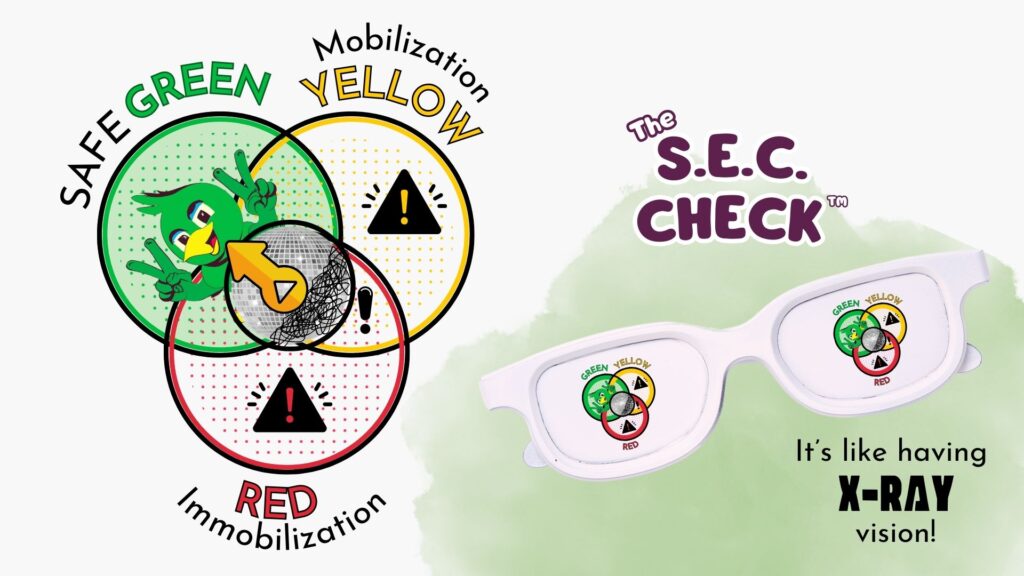This video series covers the basics of Polyvagal Theory — the 3 main states. If you love polyvagal theory and want to teach it, out our The S..E.C.™ Check Certification for Educators and Leaders here!
Video 1: Intro to Polyvagal Theory
Polyvagal Theory outlines three primary physiological states: the green state (ventral vagal) symbolizing safety and social connection, the yellow state (sympathetic nervous system) representing our fight or flight response, and the red state (dorsal vagal), a threat response where the body conserves energy via shutdown/ “disappear” when neither fighting nor fleeing is viable. This framework provides valuable insights into how we can better understand our responses to stress and interact more compassionately with others. It’s a key “X-Ray Vision” tool for professionals across various fields, from psychology and leadership to education and healthcare, aiming to promote well-being and effective communication.
Video 2: The Physiology of Safety
In this video, we explore how our nervous system continuously scans our environment for cues of threat or safety. This is called neuroception, and it happens behind the scenes… automagically for us. When it perceives safety, we enter what is known as GREEN, the ventral vagal state, characterized by a sense of safety, connection, and the capacity for social engagement and relaxation. This state activates our smarty pants brain, enhancing our ability to think clearly, solve problems, and be creative. It also influences our biological spacesuit by optimizing functions like digestion, reproduction, and immunity. This GREEN state offers access to a broad spectrum of positive emotions, feelings, and moods, such as curiosity, compassion, creativity, and courage. Why? Because the world around us is perceived as safe, so we can thrive and explore. Stay and play. Rest and digest. Broaden and build. Our inner light (authentic Self) is not blocked by the busy-ness of the survival processes. We can enter into a a flow state, fully engaged and immersed with our work… losing track of time.
Video 3: The Physiology of Mobilization in the Face of Threat
Here we delve into the YELLOW state, associated with the body’s mobilization to face perceived threats – the well-known fight or flight response activated by the sympathetic nervous system. This response is a fundamental aspect of our physiology, designed for immediate survival by prioritizing actions over analysis. When our nervous system (via neuroception) detects danger, it shifts resources accordingly: reducing blood flow to the smarty pants brain to limit overthinking (and get that juicy oxygen to where we need it — the muscles!!), while pausing non-essential functions like digestion, immunity, and reproduction. This is our body’s way of preparing us to either confront the challenge or make a swift escape. The YELLOW state is great for temporarily reallocating our resources to ensure we live to see another day. Well…. at least it’s supposed to be a temporary reallocation of resources… What happens when we stay in chronic YELLOW?
Video 4: Shutdown Due to Immobilization in the Face of Threat
This video addresses the RED state – a state of immobilization when the fight or flight response is deemed insufficient to address perceived threats. This state, governed by the dorsal vagal process, prepares the body for death, or the possibility of survival based on ‘disappearing’ through mechanisms like feigning death or shutting down in the face of insurmountable danger. In this extreme survival strategy, our body conserves energy to the utmost, significantly reducing functions like blood flow to the brain, digestion, immunity, and reproduction. It’s a physiological response to the most severe threats, where the body opts for immobilization as a form of protection. This state can leave us feeling numb and hopeless, overshadowing our inner light and authentic Self. By exploring the RED state, we gain insight into the body’s complex survival mechanisms and the profound impact they have on our mental and physical health.
Love it and Want to Teach it?
Check out our The S..E.C.™ Check Certification for Educators and Leaders here!
